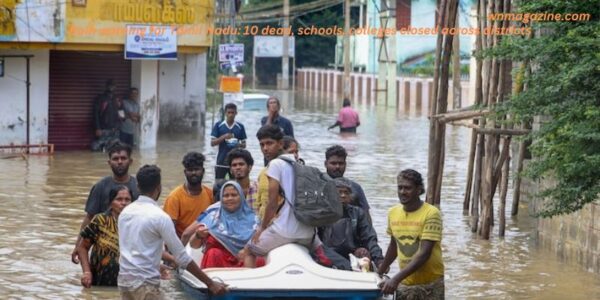On Tuesday, reports emerged detailing the devastating impact of heavy rains in Tamil Nadu, resulting in the tragic loss of ten lives. Contrary to the Indian Meteorological Department’s forecast, various southern districts experienced intense rainfall over the past two days, causing widespread disruption to residents’ lives.
10 People died
The casualties, primarily in Tuticorin and Tirunelveli districts, occurred due to incidents such as wall collapses and electrocutions. Tuticorin and Tirunelveli faced severe flooding, prompting Tirunelveli’s Collector, KP Karthikeyan, to report a total of nine casualties.
All schools and colleges have been shut down.
To ensure public safety, authorities took proactive measures, closing all schools and colleges in Thirunelveli, Tenkasi, and Thuthukudi districts. Train services were also suspended in these regions on Wednesday, with the Southern Railway canceling or partially canceling several trains, including Nagercoil-Kanniyakumari Exp Spl and Nagercoil-Tirunelveli Exp Spl.
Also Read: WELLHEALTHORGANIC VITAMIN B12
Responding to the crisis, Chief Minister MK Stalin met with Prime Minister Narendra Modi, urging him to declare the damage caused by the Michaung typhoon and heavy rain a national calamity. Stalin requested financial assistance to support livelihoods and enhance public infrastructure affected by the flooding, emphasizing the unprecedented nature of the damage in the region’s history.
Natural calamity case- MK Stalin said to PM
“I have requested 7,300 crore for immediate relief and 12,000 crore for permanent relief. We have allocated Rs 6000 as aid for those affected by the flood,” stated CM MK Stalin. He emphasized the need for prompt release of funds from the National Disaster Fund to facilitate comprehensive relief efforts.
Conclusion
In conclusion, Chief Minister MK Stalin highlighted the gravity of the situation in Thirunelveli and Thuthukudi districts, citing Kayalpatnam’s staggering 94cm of rainfall. The loss of ten lives underscored the severity of the natural calamity. With schools and colleges closed, rescue and relief operations were underway, involving 8 Ministers, 10 IAS officers, 15 SDRF teams, and 10 NDRF teams. A total of 12,553 people were rescued and accommodated in 143 shelters, with food distribution conducted using helicopters in flooded areas.
